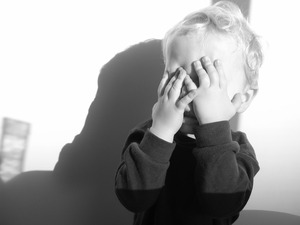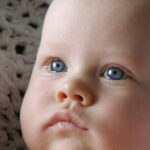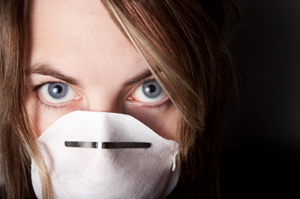My daughter has always been prone to chest infections. She was first hospitalized for breathing issues less than two months after she was born. Every cold she got settled right into her chest. After seeing her through two surgeries (tubes and adenoids, at 15 months old, and then tubes again and tonsils a year and a half later), a rather lengthy hospitalization after complications from her tonsillectomy, half a dozen ER visits, 20 or so bouts of croup, and about a million nebulizer treatments, at age four she threw us the biggest curve ball yet.
Sarah was born with a condition called Tracheomalacia, which is basically a floppy windpipe. This either caused or contributed to her many bouts with breathing issues. The diagnosis was a bit scary, but there is not usually any cause for concern. All her doctors assured us she would outgrow it. And she did, right around the time her tonsils were removed. Interestingly enough, her most recent, and in some ways scariest, ailment had nothing to do with her Tracheomalacia or with croup, though of course that is what I thought it was when I brought her to the doctors for it. To read more about Tracheomalacia, visit http://www.nlm.nih.gov/medlineplus/ency/article/001084.htm
In fact, this latest complaint can be directly traced to her daycare.
She had been sniffling and sneezing for several days. When the cough started, I was sure it was the inevitable cough that followed every cold this child had ever had. I was wrong in that it became more serious than it had been.
She came into my room, about 2 a.m., in her Minnie Mouse pajamas and dragging her poor Bitty Baby by the arm. “My belly hurts…” she told me, before launching into a coughing fit that left her gasping for air. She held her stomach and started coughing again. This time, she threw up everything in her stomach. I was scared she would choke, so I held her and calmed her down. She calmed down enough for me to drag out her nebulizer-that we hadn’t had to use in almost a year-and give her a breathing treatment. It didn’t really seem to help, so I sat upright for the next few hours, helping her breathe. She slept; I didn’t. Of course, this was a Friday night, but I called the pediatrician in the morning, and they managed to get her seen.
I was surprised when they took her temperature and she had a fever, since she hadn’t had one when we left the house. It wasn’t high, 99.8, but it was rising. The doctor listened to her breathe and instantly told me that she had pneumonia.
That scared me. I had suffered from a rather serious case about 10 years ago, and I was nearly hospitalized for it. It had taken me weeks to recover. How was a little four-year-old going to handle this rather nasty illness?
Of course, I knew I shouldn’t go home and Google “childhood pneumonia”. Of course, I did. What I learned, while scary in itself, made treating and managing Sarah’s illness much easier.
What is pneumonia?
Pneumonia, at its simplest, is an inflammation of the lungs, causing reduced breathing space. Generally, this inflammation causes fluid or mucus to accumulate in the lungs. Untreated, it can be fatal. According to The World Health Organization, is the leading cause of death of children in developing countries. Wait…I told myself. Kids die of this? But, I kept reading and learned that in children older than six months, with no other medical conditions, treated pneumonia is rarely fatal. Globally, however, one out of every three infant deaths is due to pneumonia. The sad fact is, more than half of these deaths could have been prevented by vaccines and antibiotics. To learn more about the impact of pneumonia in developing countries, visit http://www.ncbi.nlm.nih.gov/pubmed/1462653.
What are the signs and how is pneumonia diagnosed?
The first and most obvious sign of pneumonia is a deep, nasty-sounding cough that brings up mucus. Other signs are fever and chills, stabbing chest pains (which my daughter interpreted as a tummy ache), fast but shallow breathing, and confusion. Rarer, but more serious, signs of pneumonia in children included a blue tinge to skin (cyanosis), diarrhea and vomiting which can lead to dehydration, a reluctance to drink or eat anything, and even seizures.
Rales, which are crackles in the lungs heard through a stethoscope, are often the most telling sign, and many pediatricians are willing to diagnose based on rales alone, as they are rarely seen in any other illness. Other diagnostic tools used include an X-ray to look for fluid or pus in the lungs, and examination of the mucus or the lung tissue itself.
How is pneumonia treated?
Fortunately, most pneumonia can be treated at home. The first line of defense in treating pneumonia is generally antibiotics. However, very often the pneumonia is viral and will not respond to antibiotics. There are really only two sure-fire ways to tell the difference between bacterial and viral pneumonia. The first is to take a sample of the mucus and culture it. The drawbacks to this are that it can be invasive to the child and it can take some time for the culture to grow. The other way is to see if the pneumonia will respond to antibiotics. Because Sarah was running a fever, and her symptoms got worse rather suddenly, her pediatrician thought that she had a bacterial pneumonia and started her on a rather strong antibiotic. In our case, it took about a week before we saw improvement, and then she improved rapidly, proving the doctor’s guess correct. Other treatment includes rest, fluid, and nebulizer treatments. It is important to note that in general, a child with pneumonia should not be give cough medicine. This is so the child will be able to bring up the mucus, and clear out the lungs. If there is a question, always ask your doctor.
Occasionally, in more serious cases, a child will need to be hospitalized. Treatment in the hospital can include intravenous (IV) antibiotics, supplemental oxygen, and supplemental nutrition.
When should a parent seek immediate medical help?
If a child has any of the following symptoms, seek help immediately, even if the child has not been diagnosed with pneumonia. These constitute a medical emergency, so if any of these signs show up, contact your pediatrician right away, or held to the closest emergency room. If your child seems to be struggling for breath, breathing very quickly, or is turning blue on his or her fingernails or lips, seek immediate medical care. In addition, monitor your child’s fever closely; if it rises over 102 F in a child or 100.4 F in an infant, seek help right away. A high fever can be a sign of serious or worsening infection, and a quickly rising fever can lead to seizures.
To find out more about signs, symptoms, and treatment of childhood pneumonia, see http://kidshealth.org/parent/infections/lung/pneumonia.html#
Fortunately for us, Sarah’s pneumonia improved after a week and was almost completely gone after two. We need to watch her carefully in the coming months to make sure she doesn’t relapse; and I will be sure to get her vaccinated next year and each year after that. I don’t particularly care how much she hates the shots; they could certainly save her life.





